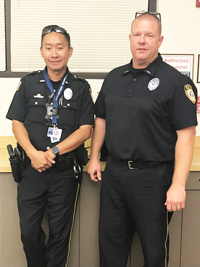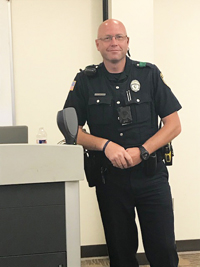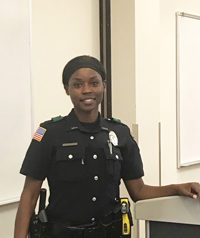The subjects of week 3 of the Garland Police Citizens Academy included lots of interesting information on Women in Policing, Traffic and DWI Enforcement.
Officer Felecia Jones talked about women in policing. She began her law enforcement career in Shreveport, Louisiana in 2008 where she enjoyed numerous accomplishments. Jones became a field training officer in 2011, attended SWAT school in 2012 and was Officer of the Year in 2013.
She came to Garland in 2015 and became a training officer in 2016. Jones joined the honor guard in 2016, worked in recruiting for a time, earned certification on the breathalyzer in 2016 and became co-captain of the color guard in 2017.
Jones said that many years ago, women were more like social workers than officers. They had to meet higher standards than the men and were paid less. They dealt primarily with women criminals. Alice Stebbins-Wells was the first woman officer with full police power. Doris Dennis was Garland’s first female officer.
In the 1970s, the Equal Employment Opportunity Act opened the field to women.
Females can now fill any departmental role — supervisors, lieutenants, captains, assistant chiefs or chiefs. The physical requirements are the same as for males and that’s how the women want it to be.
“I like that our standards are the same. I don’t want to get a pass because I’m female,” Jones said.
 Officers Jerod Weston, who has 25 years’ experience and Ted Nguyen, who has 23 years, talked to the class about the traffic unit. Both officers have additional responsibilities. Weston is a SWAT negotiator and Nguyen is in the bomb unit.
Officers Jerod Weston, who has 25 years’ experience and Ted Nguyen, who has 23 years, talked to the class about the traffic unit. Both officers have additional responsibilities. Weston is a SWAT negotiator and Nguyen is in the bomb unit.
“Our main job is to write tickets,” Nguyen said. “We enforce traffic laws to prevent accidents.”
The traffic officers also recreate accidents for investigational purposes, which requires specialized training. Accident investigation instruction consists of intermediate and advanced classes as well as an accident reconstruction class. There are formulas used to compile the most accurate information possible.
The traffic unit has eight motorcycle officers with three more coming soon. There is also a unit for commercial vehicle inspections.
I was surprised to hear that there are 3,000 reported accidents per year. Even more disturbing is that 1,200 of those are hit and run and 30-35 percent involve alcohol or other drugs.
The average number of fatal accidents in Garland per year is 15-18. In 2015, there were 11 and in 2016, 26 crashes resulted in 32 fatalities.
Weston and Nguyen said that they don’t understand why people drive as recklessly as they do.
“If we had that answer, we wouldn’t need to do this job,” Nguyen said.
Officer Thomas Griffeth shared information about DWI enforcement. He has been an officer for 22 years and has made hundreds of arrests. Sunday, Sept. 8, a new full-time DWI unit was activated and Griffeth believes that will make a positive difference.
arrests. Sunday, Sept. 8, a new full-time DWI unit was activated and Griffeth believes that will make a positive difference.
It’s surprising how little alcohol it takes to make a person drunk. The legal limit is .08 and by the time the buzz starts, a person’s level can already be at .10 to .11.
No matter what you’ve heard, it’s not true that coffee, cold showers, exercise or food helps a drunk person sober up.
“Give them coffee and you have a wide awake drunk. Have them take a cold shower and you have a cold, wet drunk. Have them work out and you have a muscled up drunk. Give them food and you have a full drunk,” Griffeth said.
There are various ways to determine if a driver is drunk. Some involve observing eye movement. Others require the driver to perform physical tasks like standing on one foot. Griffeth said that the first things to go are balance, coordination and judgement.
Driving under the influence of alcohol and other drugs is a serious problem that results in 350 DWI arrests each year.


